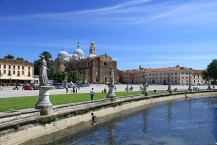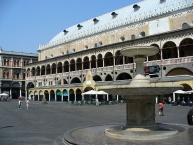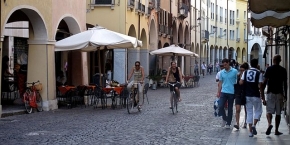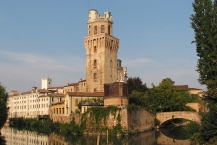Cycle Tour Po Valley - Posterior Rhine - Lake Constance - Tuttlingen
Planned tour
Actions
![]()
Please wait - map data are loading
Added on 20 Feb 2014,
last edited by ThimbleU on 15 Jan 2020
Actions
Cycle route metrics
planned
ridden
Total distance in km
1.121
0
Cumulative elevation gain in m
9.494
0
Avg. slope uphill in %
0,85
-
Cumulative elevation loss in m
8.865
0
Information about rights to the gps-track data | |
|---|---|
Rights owner | ThimbleU & biroto-Contributors |
Rights characteristic / license | cc0: Public Domain no Rights reserved |
Link to the description of the license | |
GPX file taken from | |
GPX file uploaded | by ThimbleU on 07 Jan 2020
|
Track points in total
16.446
0
Track points per km (avg)
15
0
Start/endpoint
Start location
Padua, Veneto, IT (18 m NHN)
End location
Tuttlingen, Baden-Württemberg, DE (648 m NHN)
Character
Die Tour beginnt in Padua, verläuft entlang des Brenta-Kanals nach Venedig. Ab hier folgt sie dem Radweg EuroVelo 8: Mittelmeer-Route über die Lagune an der Küste entlang bis vor das Po-Delta. Ein Abstecher ins Delta erfolgt auf dem BI-2. Zurück auf dem EV8 dann mit wenigen Abstechern entlang des Po bis Pavia. Ab dort dann auf den EuroVelo 5 "Via Romea Francigena" (EV5) über Mailand nach Como. Weiter geht es entlang des Luganer Sees und weiter nach Bellinzona.
Hier bietet sich der Postbus an, um die Höhenmeter des Alpenanstieges zu überwinden. Steigt man in San Bernardino aus, so hat man rund 1.800 Hm gespart und es bleiben noch 530 Hm bis zur Passhöhe. Oder man fährt mit dem Bus gleich bis Hinterrhein (Ersparnis 2.470 Hm).
Es geht dann auf der Graubünden-Route - Chur–Bellinzona das Hinterrhein- und auf der Rhein-Route - Andermatt-Basel weiter das Alpenrhein-Tal hinunter bis zum Bodensee, der am nördlichen Ufer auf dem Bodensee-Radweg umfahren wird.
Weiter auf der Donauroute bis Tuttlingen.
Information about copyright | |
|---|---|
Rights characteristic / license | by-sa: CREATIVE COMMONS Attribution-ShareAlike |
Link to the description of the license | |
taken over / edited on | 04 Mar 2014 - 15 Jan 2020
|
taken over / edited by |
|
Remarks
Diese Radtour ist zusammengestellt aus
- dem Radweg Vom Gardasee nach Venedig BI1,
- dem Radweg EuroVelo 8: Mittelmeer-Route,
- dem Radweg EuroVelo 5: Via Romea Francigenia,,
- dem Radweg Graubünden-Route,
- dem Radweg Rhein-Route Andermatt-Basel,
- dem Bodensee-Radweg,
- dem Hohenzollern-Radweg und
- dem Donau-Radweg.
Beds4Cyclists, worth visiting and infrastructure
Name and address
Latitude / Longitude
Phone
Fax
Mobile
Type of accommodation
Rating for cyclists
Route km
Dist. to route
Elevation
2 km
0,1 km
19 m
2 km
0,9 km
10 m
2 km
0,1 km
23 m
Information about copyright | |
|---|---|
Rights owner | |
Rights characteristic / license | by-sa: CREATIVE COMMONS Attribution-ShareAlike |
Link to the description of the license | |
Image taken over from | commons.wikimedia.org/wiki/File:Prato_della_Valle_in_Padua.JPG |
Image has been uploaded | by biroto-Redaktion on 09 Nov 2014
|
Information about copyright | |
|---|---|
Rights owner | |
Rights characteristic / license | by: CREATIVE COMMONS Attribution |
Link to the description of the license | |
Image taken over from | commons.wikimedia.org/wiki/File:Palazzo_della_Ragione_(481648033).jpg |
Image has been uploaded | by biroto-Redaktion on 09 Nov 2014
|
Information about copyright | |
|---|---|
Rights owner | |
Rights characteristic / license | by-sa: CREATIVE COMMONS Attribution-ShareAlike |
Link to the description of the license | |
Image taken over from | commons.wikimedia.org/wiki/File:Padova_juil_09_130_(8379689229).jpg |
Image has been uploaded | by biroto-Redaktion on 09 Nov 2014
|
Information about copyright | |
|---|---|
Rights owner | |
Rights characteristic / license | by-sa: CREATIVE COMMONS Attribution-ShareAlike |
Link to the description of the license | |
Image taken over from | |
Image has been uploaded | by biroto-Redaktion on 09 Nov 2014
|
Padua (Italian: Padova [ˈpaːdova], Latin: Patavium, Venetian: Padoa, German Padua (historically: Esten)) is a city and comune in the Veneto, northern Italy.
The city is picturesque, with a dense network of arcaded streets opening into large communal piazze, and many bridges crossing the various branches of the Bacchiglione , which once surrounded the ancient walls like a moat.
See
The Padua Card allows you to visit most churches and all museums as well as to use the public transport for €15.
Landmarks
- ⊙Saint Anthony's cathedral (Basilica di Sant'Antonio), Piazza del Santo (limited traffic area,parking in Prato della Valle+free shuttle bus line n° 3-8-11-12-13-16-18-22-32-43-Minibus Piazze-A-M-T and tramway line 1 stop "Basilica del Santo"-"Santa Giustina"-"Prato della Valle"), ☎ +39 0498 789722. Every day, 6.20 - 19.00 (DST 19.45). Saint Anthony's Basilica is the best-known tourist site in Padova - millions of pilgrims visit every year. Built immediately after "The Saint's" death in the 1200s, it houses his tomb and notable relics. The statues and crucifix on the main altar are by Donatello, as is the statue of horse and rider in the square in front of the church (called "Gattamelata" - "the honeyed cat"). Free entrance.
- Oratorio de San Giorgio. A beautiful, frescoed, and generally empty hall on the south side of the piazza next to the Basilica di Sant'Antonio. The paintings were done by two of Giotto's students, and though they are not as magnificent as those in the Capella degli Scrovegni, you can sit down and gaze at them undisturbed for as long as you like. Admission €2.50.
- ⊙Scrovegni Chapel (Cappella degli Scrovegni), Corso Garibaldi (parking near bus station, bus lines n° 3-8-9-10- (stop "Corso Garibaldi") 7-9-4-15 (stop "Piazzale Boschetti")), ☎ +39 0492 010020. Every day, 9.00-19.00. The Chapel is in the north of the city center, not far from the bus and train stations. The walls and ceilings are covered in frescos by Giotto, completed in 1303-1305. The chapel has been well preserved and the art is very impressive. Some of the techniques used were well ahead of their time. A must-see for art and art history fans. €12 full price, €5 student price (including Eremitani Civic Museum and Contemporary Art Museum).
Notice: Reserve your ticket/timeslot in advance or go very early. In the off-season, the wait from purchase to first available timeslot is about 4 hours unless you arrive before the hordes; in summer it's probably even longer. When you are admitted, you will be held for 15 minutes in a antechamber to lower body humidity which would otherwise damage the frescoes. During this time, you'll see a documentary presenting the chapel and its history. Then you will be allowed 15 minutes to see the frescoes before being shepherded out. - ⊙ At 90.000 square meters, Prato della Valle is the biggest square in Europe and probably one of the most beautiful in the World. Historically a Roman theater and later a fairground, it was redone in 1775 to the present layout: a large central grassy area, surrounded by a statue-lined canal, then a broad expanse of flagstones before a couple lanes of traffic are allowed to trickle around it in the distance. Saturdays the square hosts a giant market. Other large events occur frequently (concerts, fairs, etc.). The area around the canal is well-used by joggers, bikers, and rollerbladers. The square is also a great place to sit in the evening, relaxing and watching the world go by. The statues appear to have been placed precisely to be good backrests.
- ⊙Santa Giustina Basilica is along one side of Prato della Valle. When you visit, don't miss the Martyr's Hallway off of the right-front corner of the basilica.
- Roman ruins, including an Arena. The Arena is smaller and less impressive than those in Verona
 or Rome
or Rome  , but well-located in a lovely and well-maintained park. About three quarters of the Arena walls remain; the rest were removed to make way for the Scrovegni Chapel and Scrovegni Palace (the latter now long gone). In summertime, open-air movies are shown in the Arena.
, but well-located in a lovely and well-maintained park. About three quarters of the Arena walls remain; the rest were removed to make way for the Scrovegni Chapel and Scrovegni Palace (the latter now long gone). In summertime, open-air movies are shown in the Arena. - ⊙Chiesa Eremitani (near Scrovegni's Chapel). The church with an unusual wooden ceiling was badly damaged in WWII, and much of its artwork was destroyed, but what remains is beautiful.
- ⊙ The Duomo, or cathedral, is smaller than the two basilicas but not by much - don't be misled by the relatively small façade on Piazza del Duomo. Michaelangelo was involved in the cathedral's design. Inside, there are some surprisingly modern touches among the statues and artwork. The duomo is mostly known for its baptistry which is filled with frescoes in late medieval style.
Note: The cathedral closes during lunch, with no visible hours posted beside the doors. If they're closed, try again later. - Next door to the cathedral is the Baptistry, with impressive frescos by Giotto.
- Astronomic Observatory (La Specola), 5, Vicolo dell'Osservatorio (bus n° 12 or 18, stop "Via P. Paoli", turn to via S. Alberto Magno to reach the Specola tower), ☎ +39 0498 759840. Sa-Su 11.00-16.00 (18.00 May-Oct). Although the observatory was build after Galileo's time in Padua, you'll learn a lot about his significance for the research in Padua. You reach the top of the tower after a lecture of about one hour and can enjoy the view. Tickets at the Oratorio S. Michele, Piazzetta S. Michele, 1: 50 meters from the Specola, through the arcade on the right before the little bridge.
- ⊙Palazzo della Ragione. The large building located between Piazza della Frutta and Piazza delle Erbe. Its ground floor hosts small market shops. The upper floor is a single large hall housing artwork and occasional exhibitions.
- Jewish Ghetto (between Piazza della Frutta, the Duomo, and via Roma). Characterized by narrow streets and many small art galleries and bars where to enjoy a "spritz".
- ⊙ Palazzo del Bo', The main university building. Padua's university is the second oldest in Italy (founded 1222). Gallileo taught at the university in the late 1500s/early 1600s.
- ⊙Botanic Garden. The world's oldest still operating botanic garden, operated by the University of Padua, and on the UNESCO World Heritage list since 1997. It isn't a large garden, but subtly laid out to swallow groups of people and give the impression of solitude. Do not miss the carnivorous plants, or the wooded hill at the southeast corner mounted by a double helix pair of paths. Admission ranges from free (for some university students) to €1 (for other university students) to €4-5 for everyone else.
- Most of the City walls of Padua have been made into the borders of people's back yards, but you can still roughly follow their route. At the northern gates leading towards the train station is a terraced garden leading up to the old water tower.
- If you have extra time before your bus or train, visit Tempio Antonio della Pace, the large brick church a few minutes' walk away. The interior is light and airy - very appropriate for a place dedicated to Peace - and the walls are a subtle but moving memorial to the 5401 WWI soldiers and 989 civilian victims of WWII who are buried there.
Museums
- Belzoni Museo-Laboratorio di Antichi Strumenti Scientifici, Via Speroni Sperone, 39/41, ☎ +37 0496 55157. School hours (9:30-12:30 weekdays) and certain Saturdays. This is a very peculiar museum, a collection of old scientific instruments assembled by Professor Pietro Paolo Gallo, a teacher of physics at a technical highschool, which also houses the museum in a couple of its rooms. No one speaks anything but Italian, and they are not prepared for anything more than a few enthusiasts. Tell the secretary at the school's entrance that you would like to see the scientific instruments, and she will attempt to find Professor Gallo for you. Free admission, but Professor Gallo has a few instruments he cannot identify, and you may be interrogated if you have any knowledge of what they might be.
- Eremitani Civic Museum (Museo Civico Agli Eremitani), Piazza Eremitani 8. The museum is divided into an archeological section and a picture gallery, which has a very important collection with Tizian, Tintoretto, Giotto and Bellini among other important painters.
Information about copyright | |
|---|---|
Rights characteristic / license | by-sa: CREATIVE COMMONS Attribution-ShareAlike |
Link to the description of the license | |
Input taken over from: |
Wikipedia contributors, 'Padua', Wikipedia, The Free Encyclopedia, 31 October 2014, 22:42 UTC, <http://en.wikipedia.org/w/index.php?title=Padua&oldid=631946114> [accessed 9 November 2014] Wikivoyage contributors, 'Padua', Wikivoyage, The FREE worldwide travel guide that anyone can edit, 17 August 2016, 06:30 UTC, <https://en.wikivoyage.org/w/index.php?title=Padua&oldid=3035342> [accessed 14 September 2016] |
taken over / edited on | 09 Nov 2014 - 14 Sep 2016
|
taken over / edited by |
|
2 km
0,1 km
20 m
Hours of opening
Montag - Samstags von 9.00 bis 19.00 Uhr.
2 km
0,5 km
18 m
![]()




